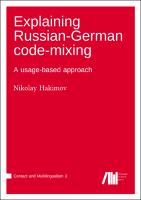Explaining Russian-German code-mixing
A usage-based approach (Volume 3)
| dc.contributor.author | Hakimov, Nikolay | |
| dc.date.accessioned | 2022-01-27T05:31:10Z | |
| dc.date.available | 2022-01-27T05:31:10Z | |
| dc.date.issued | 2021 | |
| dc.identifier | OCN: 1296692617 | |
| dc.identifier.uri | https://library.oapen.org/handle/20.500.12657/52586 | |
| dc.description.abstract | The study of grammatical variation in language mixing has been at the core of research into bilingual language practices. Although various motivations have been proposed in the literature to account for possible mixing patterns, some of them are either controversial, or remain untested. Little is still known about whether and how frequency of use of linguistic elements can contribute to the patterning of bilingual talk. This book is the first to systematically explore the factor usage frequency in a corpus of bilingual speech. The two aims are (i) to describe and analyze the variation in mixing patterns in the speech of Russia German adolescents and young adults in Germany, and (ii) to propose and test usage-based explanations of variation in mixing patterns in three morphosyntactic contexts: the adjective-modified noun phrase, the prepositional phrase, and the plural marking of German noun insertions in bilingual sentences. In these contexts, German noun insertions combine with either Russian or German words and grammatical markers, thus yielding mixed bilingual and German monolingual constituents in otherwise Russian sentences, the latter also labelled as embedded-language islands. The results suggest that the frequency with which words are used together mediates the distribution of mixing patterns in each of the examined contexts. The differing impacts of co-occurrence frequency are attributed to the distributional and semantic specifics of the analyzed morphosyntactic configurations. Lexical frequency has been found to be another important determinant in this variation. Other factors include recency, or lexical priming, in discourse in the case of prepositional phrases, and phonological and structural similarities and differences in the inflectional systems of the contact languages in the case of plural marking. | |
| dc.language | English | |
| dc.subject.classification | thema EDItEUR::C Language and Linguistics::CF Linguistics | en_US |
| dc.subject.other | Language Arts & Disciplines | |
| dc.subject.other | Linguistics | |
| dc.title | Explaining Russian-German code-mixing | |
| dc.title.alternative | A usage-based approach (Volume 3) | |
| dc.type | book | |
| oapen.identifier.doi | https://doi.org/10.5281/zenodo.5589446 | |
| oapen.relation.isPublishedBy | 0bad921f-3055-43b9-a9f1-ea5b2d949173 | |
| oapen.relation.isFundedBy | b818ba9d-2dd9-4fd7-a364-7f305aef7ee9 | |
| oapen.relation.isbn | 9783961103300 | |
| oapen.collection | Knowledge Unlatched (KU) | |
| oapen.imprint | Language Science Press | |
| oapen.identifier | https://openresearchlibrary.org/viewer/a023b6bf-9383-467a-b498-4f1694d1f149 | |
| oapen.identifier.isbn | 9783961103300 |

